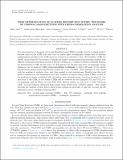Files in this item
First determination of 2D speed distribution within the bodies of coronal mass ejections with cross-correlation analysis
Item metadata
| dc.contributor.author | Ying, Beili | |
| dc.contributor.author | Bemporad, Alessandro | |
| dc.contributor.author | Giordano, Silvio | |
| dc.contributor.author | Pagano, Paolo | |
| dc.contributor.author | Feng, Li | |
| dc.contributor.author | Lu, Lei | |
| dc.contributor.author | Li, Hui | |
| dc.contributor.author | Gan, Weiqun | |
| dc.date.accessioned | 2019-07-31T16:30:03Z | |
| dc.date.available | 2019-07-31T16:30:03Z | |
| dc.date.issued | 2019-07-23 | |
| dc.identifier | 259207450 | |
| dc.identifier | 7b4290a8-f92b-4e7d-8f66-a68499c0e4d8 | |
| dc.identifier | 000476896700006 | |
| dc.identifier | 85071922519 | |
| dc.identifier.citation | Ying , B , Bemporad , A , Giordano , S , Pagano , P , Feng , L , Lu , L , Li , H & Gan , W 2019 , ' First determination of 2D speed distribution within the bodies of coronal mass ejections with cross-correlation analysis ' , Astrophysical Journal , vol. 880 , no. 1 , 41 . https://doi.org/10.3847/1538-4357/ab2713 | en |
| dc.identifier.issn | 0004-637X | |
| dc.identifier.uri | https://hdl.handle.net/10023/18216 | |
| dc.description | Funding: this research has received funding from the the European Union Horizon 2020 research and innovation programme (grant agreement No. 647214). | en |
| dc.description.abstract | The determination of the speed of coronal mass ejections (CMEs) is usually done by tracking brighter features (such as the CME front and core) in visible light (VL) coronagraphic images and by deriving unidimensional profiles of the CME speed as a function of altitude or time. Nevertheless, CMEs are usually characterized by the presence of significant density inhomogeneities propagating outward with different radial and latitudinal projected speeds, resulting in a complex evolution eventually forming the interplanetary CME. In this work, we demonstrate for the first time how coronagraphic image sequences can be analyzed with the cross-correlation technique to derive two-dimensional (2D) maps of the almost instantaneous plasma speed distribution within the body of CMEs. The technique is first tested with the analysis of synthetic data and then applied to real observations. Results from this work allow us to characterize the distribution and time evolution of kinetic energy inside CMEs, as well as the mechanical energy (combined with the kinetic and potential energy) partition between the core and front of the CME. In the future, CMEs will be observed by two channels (VL and UV Lyα) coronagraphs, such as Metis on board ESA Solar Orbiter mission as well as the Lyα Solar Telescope on board the Chinese Advanced Space-based Solar Observatory mission. Our results will help in the analysis of these future observations, helping in particular to take into account the 2D distribution of Lyα Doppler dimming effect. | |
| dc.format.extent | 14 | |
| dc.format.extent | 1712665 | |
| dc.language.iso | eng | |
| dc.relation.ispartof | Astrophysical Journal | en |
| dc.subject | Magnetohydrodynamics (MHD) | en |
| dc.subject | Methods: data analysis | en |
| dc.subject | Sun: coronal mass ejections (CMEs) | en |
| dc.subject | Sun: UV radiation | en |
| dc.subject | Techniques: polarimetric | en |
| dc.subject | QB Astronomy | en |
| dc.subject | QC Physics | en |
| dc.subject | DAS | en |
| dc.subject.lcc | QB | en |
| dc.subject.lcc | QC | en |
| dc.title | First determination of 2D speed distribution within the bodies of coronal mass ejections with cross-correlation analysis | en |
| dc.type | Journal article | en |
| dc.contributor.sponsor | European Research Council | en |
| dc.contributor.institution | University of St Andrews. Applied Mathematics | en |
| dc.identifier.doi | 10.3847/1538-4357/ab2713 | |
| dc.description.status | Peer reviewed | en |
| dc.date.embargoedUntil | 2019-07-23 | |
| dc.identifier.grantnumber | 647214 | en |
This item appears in the following Collection(s)
Items in the St Andrews Research Repository are protected by copyright, with all rights reserved, unless otherwise indicated.

